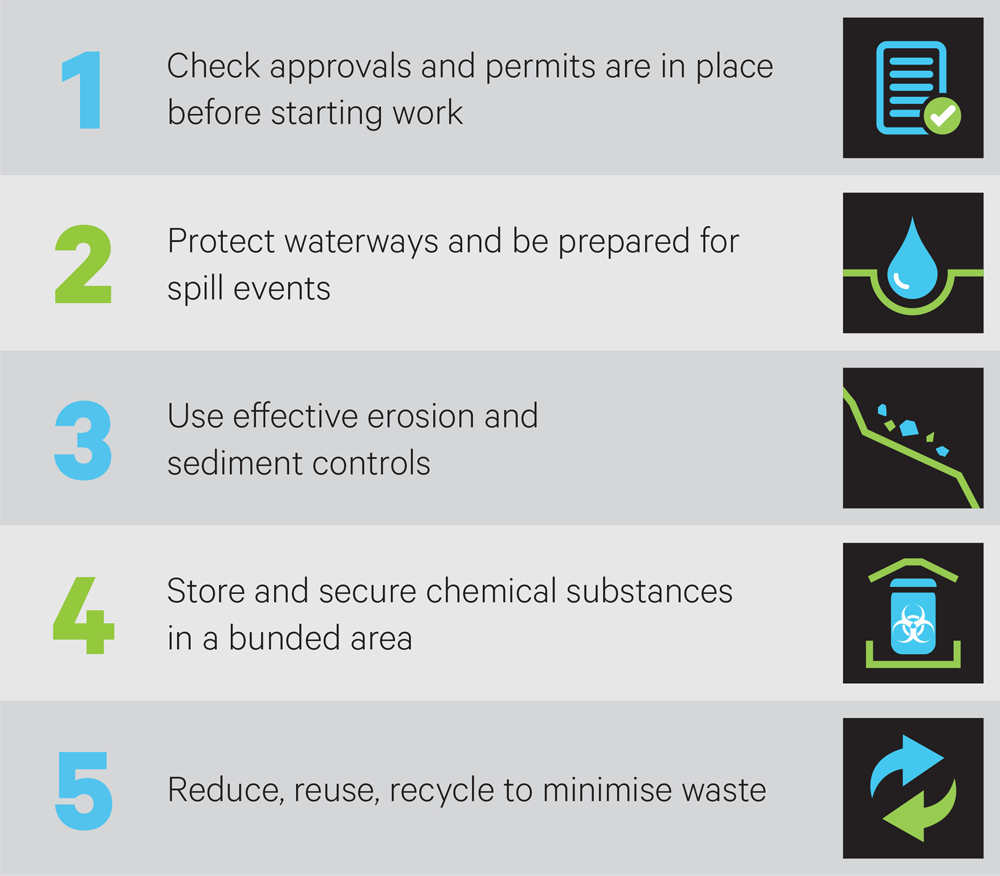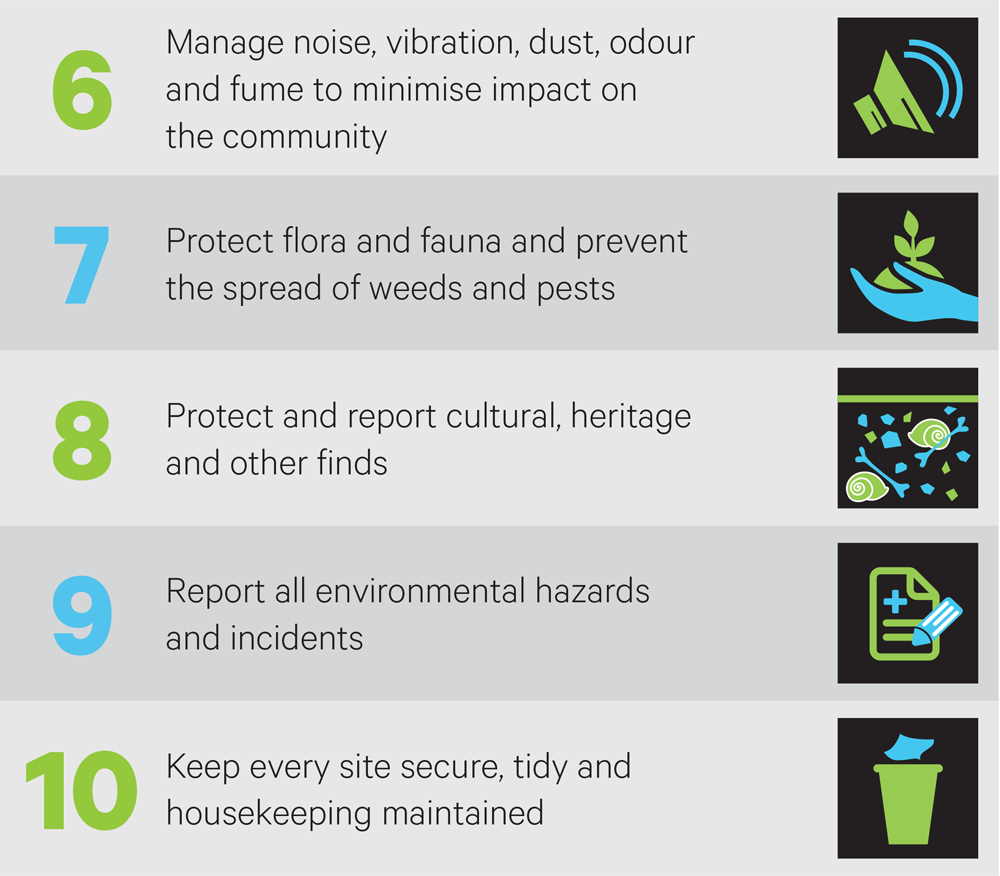Our approach
Downer strives for environmental excellence and enhancing liveability for all communities in which we operate.
Our environmental commitments are outlined in Downer’s Environmental Sustainability Policy on the Downer website.
Our ability to manage the impacts of our activities on the environment and communities in which we operate is fundamental to our long-term success. At Downer, we help our customers succeed by developing and delivering environmentally responsible and sustainable solutions, so our business is fit for the future.
Downer remains focused on developing solutions to reduce our energy consumption and greenhouse gas (GHG) emissions, while increasing our cost competitiveness. We are also committed to developing strategies that will improve the resilience of our assets and portfolio to the impacts of climate change, progressing the circular economy and looking at innovative ways to reuse waste materials in our products.
We place a strong emphasis on meeting our compliance obligations, including taking responsibility for preventing and managing our contamination risk and liabilities.
Each Division is required to have an Environmental Sustainability Action Plan (ESAP) and strategies in place supported by suitably qualified environment and sustainability professionals. The ESAP allocates internal responsibilities for reducing the impact of our operations and business activities on the environment. In addition, all Downer Divisions’ environment management systems are audited by both internal and external independent third parties.
Our 10 Environmental Principles were created as an important central awareness and engagement tool, providing practical messages to assist our frontline workers to achieve environmental compliance across waste, water, air emissions, hazardous waste and substances, flora and fauna, heritage and environmental incidents. They provide us with the necessary understanding and tools to ensure we conduct our operations and activities in a manner that is environmentally responsible and sustainable. These principles are critical to ensuring our employees and broader stakeholder groups are engaged and aware of our environmentally sustainable commitments.
In FY19, Downer committed to achieving the following environmental targets and objectives:
- Zero serious environmental incidents (Level 5 and 6)
- Zero Environmental Prosecutions
- Fewer than three Environmental Penalty Infringement Notices
- Achieve a ‘Stretch’ target1 of 7,166 tonnes of annualised GHG emission (CO2-e) reductions for energy efficiency initiatives.
The performance information in this section includes Downer, its contractors and joint ventures in the following business lines: Transport and lnfrastructure; Mining, Energy and Industrial; Spotless; and New Zealand including Hawkins. Joint ventures have been included for environmental energy and GHG emission performance data where Downer is deemed to have operational control as defined by the National Greenhouse Energy Reporting Act. Further information on joint ventures is detailed in Downer’s 2019 Annual Report.
Environmental
Principles
Following these principles will enable us to meet our obligations and commitments, protect the surrounding environment and maintain positive relationships with our community and customers.


Spotless uses less energy
Our performance
Downer’s environmental sustainability performance is measured against the key areas of risk management, compliance, minimising environmental impact and maximising resource efficiency opportunities in our own and our customers’ businesses. Significant progress was made this year in delivering on focus areas that were disclosed in Downer’s 2018 Sustainability Report.
Downer’s key focus areas during the year were to:
- Continue to focus on the resilience and assurance of environmental risk controls
- Incorporate sustainability rating tools and initiatives into major projects
- Improve environmental workforce capability
- Engage with customers regarding Downer’s environmental capability
- Prepare the business as markets transition to a low carbon economy.
Last year Downer committed to improving and consolidating all reporting within our sustainability reporting platform, including incorporating water and waste data. Over the past year, improvements have been made to our Envizi platform. Collection of reliable waste and water data continues to be a challenge, but we have put strategies in place to enable this to be completed in FY20.
We reset the base year GHG emissions levels to FY18, and reviewed and set new three-year GHG reduction plans and targets, as outlined in the GHG emissions section. This year Downer also further explored the impacts of climate-related risks and opportunities through scenario analysis and development of science-based targets as we progress with responding to the recommendations of the Task Force on Climate-related Financial Disclosures (TCFD).
Other areas Downer focused on in FY19 were to:
- Expand the scope of GHG emissions reporting to include contractor data for New Zealand and Spotless in line with the rest of the business and joint ventures
- Review our ISO certifications and integrated management systems to align to new business structures
- Further utilise low-emission technology across our fleet and machinery to reduce fuel consumption, carbon and air emissions
- Develop company-wide procedures to ensure a consistent approach to identifying and assessing land contamination at sites we own or have acquired, leased or sub-leased
- Further develop a suite of learning modules for operational staff on various environmental management and sustainability topics
- Apply LCA (life cycle assessment) to our Transport and Infrastructure Division, including the development of an Environmental Product Declaration (EPD) for the Sydney Growth Trains (Waratah Series 2) and LCA for our Rosehill Detritus plant and road maintenance services
- Increase the number of Infrastructure Sustainability Council of Australia (ISCA) Infrastructure Sustainability (IS) ratings for our infrastructure projects to improve our sustainability performance, including being the first Tasmanian project to register for an IS Operational rating.
Pioneering rolling stock lifecycle transparency in Australia
Environmental compliance
Downer maintained its Group-wide target of zero Level 52 or Level 63 environmental incidents and zero Significant Environmental Incidents4 and zero prosecutions during FY19.
Contamination management
Downer participates in a number of high-risk activities with regard to contamination. These include emulsion manufacturing, asphalt manufacturing, rail maintenance, commercial laundry and dry-cleaning operations.
In 2019 Downer undertook a review of its Contamination Management procedure which it launched in 2017. This procedure provides a consistent approach to contamination management across the Group, with key responsibilities outlined for the Property and Zero Harm teams throughout the property acquisition and divestment process; and guidance to the business to assist in identifying potential liabilities and reducing potential risks associated with the Downer property portfolio. The procedure also provides an outline on how and when potential contamination risks are identified and managed for the following transactions: newly acquired (leased, purchased or subleased) land by Downer; sites to be divested or ending their lease by Downer; and land that Downer subleases to a third party.
A core group of in-house contamination specialists within the Environment and Sustainability team of Group Zero Harm provides technical advice and support to the business and actively engages in all major tenders, acquisitions and divestments. Contamination liability is a key consideration.
In addition, a Group-wide Contamination Risk register, initially prepared in 2017, collates information from detailed reviews of Downer’s leasehold and freehold properties. Each property is assigned a risk rating in accordance with Downer’s risk classifications. This register includes the Laundry facilities in Spotless, which already had a well-established contamination program. The Group Contamination Risk register and supporting information is provided to Divisional Finance teams to allow for financial provisions to cover any make good or site remediation obligations.
Climate change and Downer’s TCFD response
Downer accepts the latest Intergovernmental Panel on Climate Change (IPCC) assessment of the science related to climate change. Downer considers climate change to be one of its material issues.
Read more
Downer continues to make significant progress in assessing the financial implications of climate change. In 2019 Downer fulfilled the recommendations of the TCFD and focused on scenario analysis and developing a science-based target, as detailed below.
In FY19 Downer published a set of climate change frequently asked questions on its website www.downergroup.com/environment to provide a consistent response to questions Downer receives on climate change.
The impacts of climate change present a challenge to sustaining our modern environment. While our business portfolio is diverse, we have limited exposure to the effects of climate change on our business through fixed, long-lived capital assets. Our diverse portfolio allows us to be flexible and agile to redeploy our assets to high-growth areas as markets change. This diversity of portfolio strongly positions us to mitigate and manage our exposure to climate risks and to maximise the business opportunities it presents.
Our climate-related disclosures which are aligned with the recommendations of the Financial Stability Board’s Task Force on Climate-related Financial Disclosures (TCFD) are detailed against the four themes, Governance, Strategy, Risk Management and Metrics and Targets and build on our initial climate disclosures in FY17 and FY18.
Governance and Risk management
The Downer Board, through its oversight functions, has ensured Downer appropriately considers Environmental Social and Governance (ESG) risks including those related to climate change.
Environment performance data
Strategy
Our existing Group and Divisional strategy process considers key external drivers, as stated above. We have also enhanced our strategy process to incorporate more explicitly climate-related risks and opportunities on an ongoing basis. We have embedded this process in the annual Group strategy session and a similar process into the Divisional strategy sessions.
Outlined in the climate-related risk and opportunity tables above are Downer’s key climate-related risks and opportunities. These risks and opportunities are not listed in order of significance and are not intended to be exhaustive. They represent the most significant risks identified during FY19 and are informed by a combination of review of Group and service line strategic documents and risk registers, interviews with senior management, and workshops with Divisional leadership teams.
This process confirmed that at present, there are no material short-term climate-related risks for the Group. As indicated in the tables, the majority of Downer’s climate-related risks have been deemed to impact the business in the medium to longer-term. Opportunities identified relate primarily to leveraging Downer’s existing capabilities and business model as a service provider to service new and adjacent markets that will continue to emerge as a result of the transition to a low carbon economy.
BESS is best for Ballarat
TCFD scenario analysis
In 2019 Downer completed scenario analysis to test the resilience of our strategy and the assumptions underpinning the strategic focus areas in relation to the relevant climate futures both physical and transitional.
GHG emissions
A key consideration of the TCFD recommendations is the pathway to reduce emissions and the establishment of targets.
Climate Leaders Coalition
Our future focus
In FY20, Downer will continue to focus on driving improvement in our environmental and sustainability performance and risk management while further embedding sustainability within our business.
To achieve this we will:
- Continue to diversify our business and provide services to sectors that promote a sustainable future and transition to a low carbon economy, including renewable energy, facilities management, water treatment, telecommunications, sustainable transport, waste to energy and waste recovery
- Further utilise low-emission technology across our fleet and machinery to reduce fuel consumption, carbon and air emissions
- Apply LCA (life cycle assessment) to our Transport and Infrastructure Division, including the development of an Environmental Product Declaration (EPD) for our Rosehill Detritus plant and road maintenance
- Increase the number of Sustainability Ratings such as ISCA IS ratings for our infrastructure projects to improve our sustainability performance
- Establish a baseline data for waste, and set waste to landfill reduction targets.

